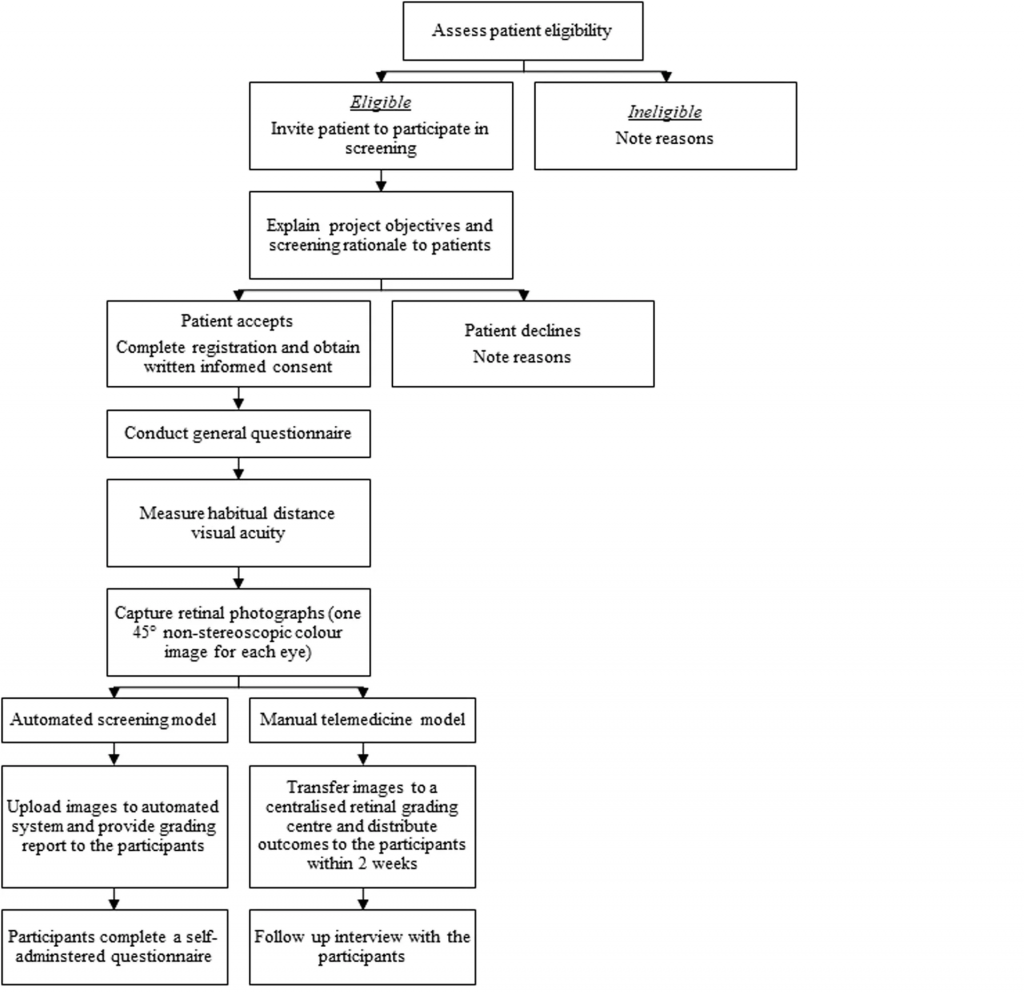(Featured AI and Healthcare) Automatic screening of diabetic retinopathy with AI! How satisfied is the patient? (Publication)
[論文] S. Keel, P. Y. Lee, J. Scheetz, Z. Li, M. A. Kotowicz, R. J. MacIsaac, M. He , “Feasibility and patient acceptability of a novel artificial intelligence-based screening model for diabetic retinopathy at endocrinology outpatient services: a pilot study”. Scientific Reports, 8, 4330 (2018). [DOI: 10.1038/s41598-018-22612-2]
3つの要点
✔️糖尿病網膜症(DR)における、AIベースのスクリーニングの実現性について調査した。
✔️AIベースの自動スクリーニングモデルと手動スクリーニングモデルを患者に体験してもらい、満足度についてのアンケートを実施した。
✔️自動モデルについての患者の満足度および診断の精度はともに高く、実行可能性は十分にあると考えられる。
概説
本研究の目的は、内分泌外来患者という条件のもとで、新規人工知能(Artificial Intelligence;AI)ベースの糖尿病網膜症(Diabetic Retinopathy;DR)スクリーニングモデルの実現可能性、および患者の許容性を評価することである。糖尿病患者の成人は2つの都市内分泌外来診療所から募集され、単一視野の非散瞳性眼底写真が撮影され、参照可能なDR(≧増殖前DR)についてランク付けがされた。各参加者は以下の2つを体験した。
(1)ディープラーニングアルゴリズム(DLA)が結果をリアルタイムで知らせる自動スクリーニングモデル
(2)網膜画像が網膜グレーディングセンターに転送され、手動グレーディングの結果が評価の2週間以内に患者に配布される手動モデル
参加者は、全体的な満足度と良質なケアのモデルを決定するために、検査当日と評価の1ヵ月後にアンケートを受けた。合計96人の参加者がDRについてスクリーニングされ、自動スクリーニングの平均評価時間は6.9分であった。参加者の96%が、自動スクリーニングモデルに非常に満足もしくは満足していると回答し、78%が手動モデルよりも自動モデルを好むと回答した。正しい紹介に対するDLAの感度と特異度は、それぞれ92.3%と93.7%であった。内分泌外来患者という条件下におけるAIベースのDRスクリーニングは、実行可能であり、そして患者によって十分に受け入れられていると考えられる。

研究の説明に合意を得られた患者に対して、自動スクリーニングと手動スクリーニングを実施した。その後アンケートを行ったところ、参加者の96%は満足もしくは非常に満足していると答えた。また、参加者の78%は手動モデルよりも自動モデルを好むと回答した。
著者
Stuart Keel (Centre for Eye Research Australia, Royal Victorian Eye & Ear Hospital, Melbourne, Australia)
Pei Ying Lee (Centre for Eye Research Australia, Royal Victorian Eye & Ear Hospital, Melbourne, Australia)
Jane Scheetz (Centre for Eye Research Australia, Royal Victorian Eye & Ear Hospital, Melbourne, Australia)
Zhixi Li (State Key Laboratory of Ophthalmology, Zhongshan Ophthalmic Center, Sun Yat-sen University, Guangzhou, China)
Mark A. Kotowicz (Department of Endocrinology & Diabetes, Barwon Health, Geelong, Australia / Deakin University, Geelong, Australia / Melbourne Medical School – Western Campus, Department of Medicine, The University of Melbourne, St Albans, Australia)
Richard J. MacIsaac (Department of Endocrinology & Diabetes, St Vincent’s Hospital, Melbourne, Australia / Department of Medicine, The University of Melbourne, Parkville, Australia)
Mingguang He (Centre for Eye Research Australia, Royal Victorian Eye & Ear Hospital, Melbourne, Australia / State Key Laboratory of Ophthalmology, Zhongshan Ophthalmic Center, Sun Yat-sen University, Guangzhou, China)
出版情報
Received: 28 November 2017 / Accepted: 26 February 2018 / Published: 12 March 2018
Open Access This article is licensed under a Creative Commons Attribution 4.0 International License, which permits use, sharing, adaptation, distribution and reproduction in any medium or format, as long as you give appropriate credit to the original author(s) and the source, provide a link to the Creative Commons license, and indicate if changes were made. The images or other third party material in this article are included in the article’s Creative Commons license, unless indicated otherwise in a credit line to the material. If material is not included in the article’s Creative Commons license and your intended use is not permitted by statutory regulation or exceeds the permitted use, you will need to obtain permission directly from the copyright holder. To view a copy of this license, visit http://creativecommons.org/licenses/by/4.0/.
■サポートのお願い
AIDBを便利だと思っていただけた方に、任意の金額でサポートしていただけますと幸いです。







 PAGE TOP
PAGE TOP